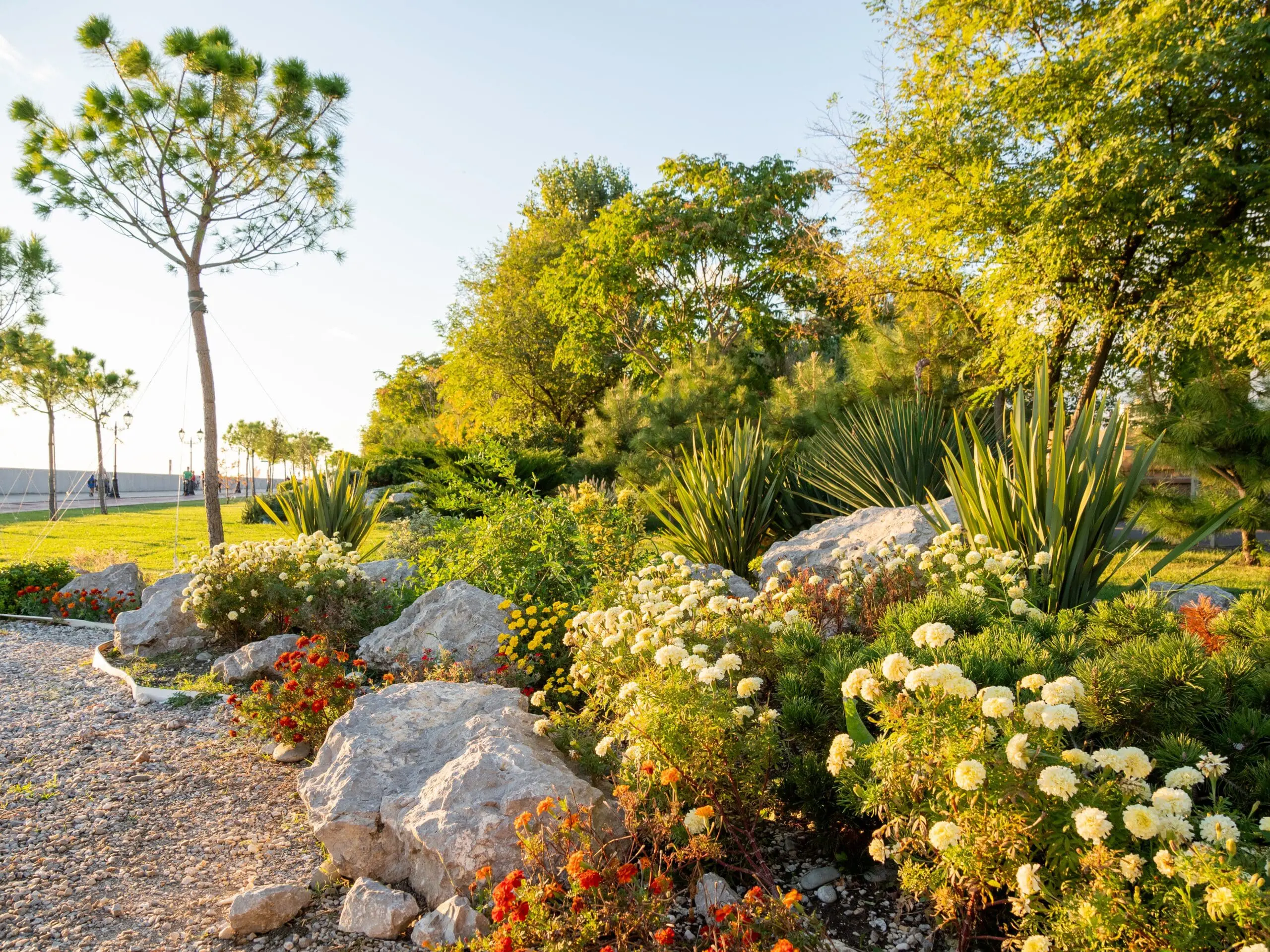
The Art of Xeriscaping: A Guide to Eco-Friendly Landscape Design
As homeowners become increasingly environmentally conscious, the desire for eco-friendly and sustainable landscape solutions has grown significantly. One such approach that has gained in popularity is xeriscaping – an eco-friendly landscape design technique that emphasizes the use of drought-resistant and native plants to create a low-maintenance and water-efficient outdoor space. The term “xeriscaping” arises from combining the Greek word “xeros,” meaning dry, with landscaping, emphasizing its focus on water conservation.
But xeriscaping is more than just planting succulents and cacti. It involves a thoughtful design process that incorporates various principles, such as efficient irrigation, effective soil management, and creative landscaping elements, to develop an outdoor space that is both attractive and environmentally sustainable.
With xeriscaping, you can cultivate a vibrant, diverse, and visually appealing landscape that not only saves water but also supports the local ecosystem.
Keystone Yards, a premier outdoor remodeling contractor in Napa, Sonoma, and Marin County, is excited to offer this comprehensive guide to the art of xeriscaping. We will discuss the main principles and benefits of xeriscaping, as well as offer expert advice on how to select and arrange appropriate plants to maximize visual appeal and environmental advantages.
So, whether you are a seasoned gardener looking for sustainable alternatives or a homeowner seeking inspiration for an environmentally friendly yard, this guide will provide the information and insights needed to embrace the eco-friendly practice of xeriscaping.
Understanding the Principles of Xeriscaping
Xeriscaping revolves around seven fundamental principles forming a cohesive approach to eco-friendly landscape design.
Adhering to these guidelines ensures an effective and sustainable yard that is visually appealing and conserves valuable natural resources.
- Planning and design: Proper planning lays the foundation for a successful xeriscape. When mapping the space, consider elements like sun exposure, drainage patterns, and existing structures.
- Soil improvement: Improving soil quality is vital for xeriscaping success. Focus on enhancing soil composition by adding organic matter, which promotes better water retention and absorption.
- Efficient irrigation: To optimize water usage, opt for drip irrigation, soaker hoses, or self-watering containers that target plant roots directly, minimizing evaporation and runoff.
- Plant selection: Choose drought-tolerant and native plant species that will thrive with minimal water requirements, support local ecosystems, and reduce the need for pesticides and fertilizers.
- Mulching: Applying a layer of mulch around plants helps conserve water by reducing evaporation, moderating soil temperature, and preventing weed growth.
- Maintenance: Regularly prune, weed, and monitor your xeriscaped yard to maintain its health, beauty, and effectiveness.
- Turf reduction: Limiting the size of turf areas allows for considerable water savings while still providing an area of lush greenery for play and relaxation.
What Are the Benefits of Xeriscaping?
In addition to conserving water, xeriscaping offers various potential benefits to homeowners, the environment, and local ecosystems. Some of these advantages include:
- Less water usage: A well-designed xeriscape can decrease water consumption by 50-75%, greatly reducing monthly utility bills.
- Low maintenance: Xeriscaping often requires less mowing, pruning, and fertilizing, substantially reducing landscape maintenance efforts and expenses.
- Property value boost: Aesthetic and eco-friendly landscape designs can enhance the appeal and value of your property.
- Environmental impact: Xeriscaping promotes sustainable resource use, reducing the strain on water reserves and lowering the emission of lawnmowers and other gardening equipment.
- Local ecosystem support: By incorporating native plants, xeriscaping helps preserve local biodiversity, providing natural habitats and resources for birds, pollinators, and other beneficial organisms.
Selecting appropriate plant species for your xeriscape is crucial to achieving optimal results. When curating a plant palette for your landscape, consider the following guidelines:
How to Choose the Right Plants for Xeriscaping
- Opt for native plants: Native plants are well-adapted to local climate conditions and require less maintenance. They also support local ecosystems by providing food and shelter for native wildlife.
- Prioritize drought-tolerant species: Drought-tolerant plants can better withstand prolonged periods of low precipitation, which is ideal for xeriscaping.
- Consider plant characteristics: Choose plants with various shapes, textures, colors, and blooming schedules to create a vibrant, dynamic landscape throughout the year.
- Group plants with similar needs: Arrange plants with similar water, sunlight, and soil requirements together for efficient irrigation and maintenance.
4. Design Tips for Creating an Attractive Xeriscape
A well-designed xeriscape can showcase a lush, visually stunning outdoor space brimming with variety and interest. Consider these design tips to elevate your xeriscape’s aesthetic appeal:
- Layering: Combine plants of various heights, sizes, and textures to create depth, dimension, and visual interest.
- Color and foliage: Incorporate plants that boast vibrant and colorful foliage or flowers, drawing the eye and capturing attention.
- Statement pieces: Place eye-catching specimen plants, boulders, or sculptural elements as focal points to anchor your landscape design.
- Hardscaping: Hardscaping elements such as pathways, patios, and decorative borders can add structure and organization to your xeriscaped yard.
Final Thoughts
Xeriscaping is an eco-friendly landscape design and sustainable landscaping approach that marries conservation with captivating design. By understanding the principles of xeriscaping, reaping its benefits, and skillfully selecting and arranging plants, you can create a visually stunning, low-maintenance, and environmentally conscious outdoor space that is both satisfying and rewarding.
If you’re ready to embrace the art of xeriscaping and transform your landscape into a sustainable haven, contact the experts at Keystone Yards for a personalized consultation on custom landscaping design in Napa, Sonoma, or Marin County.





